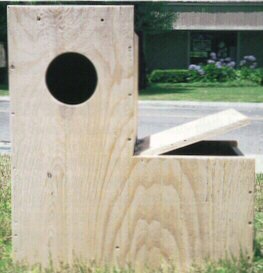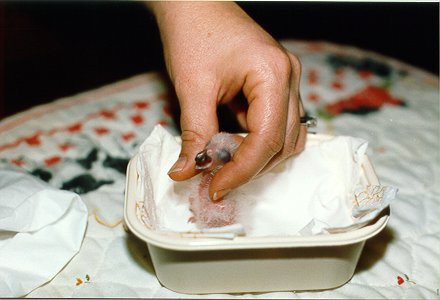
A True Pair

Most domestic raised birds will be mature enough for breeding around five years of age. Wild caught birds seem to take a bit longer, being seven to eight years of age. This is probably due to the less nutrient-rich diet found in the wild as compared to todays handfeeding diets. We begin pairing up our babies at six months of age. This way they get used to being with other birds and learn natural behaviors. Our birds stay sweet and affectionate even after bonding with their mates. I have six and seven year old males who still give me kisses and gently pull my hair as I clean the inside of their cages!

After you are sure you have a true pair of birds, the next step is designing and building a suitable breeding cage. You can also purchase a manufactured cage if you do not want to build one. We breed our pairs in cages with the following dimensions: 4'(w) x 2'(d) x 5'(h). We make our own cages using 1" x 2" wire and galvanized angle iron for the frame. The picture above is an example. African Grey parrots breed quicker and more often in these size cages than in larger flights. This has been discovered by many breeders of these birds. Our birds seem to get plenty of exercise by hanging from the top and flapping their wings.
You will need good sturdy perches for these birds. The male grey mates with his hen by physically climbing up on her back unlike amazons and macaws that breed from the side. We use 2'x 4' boards for our perches. This allows for lots of wood chewing which is done during the breeding cycle. We purchase non-pressure treated 2 by 4's at a local Home Depot store. "Yellow pine" is prefered since it is harder and lasts longer. We use stainless steel dishes and glass quart water bottles for our breeding cages. These can all be safely washed in the dishwasher where they are sanitized. We have also built swing out feeder doors on all cages which makes it easy to service. Cage grates are cleaned daily and papers changed.
We use the "L"-shaped nestbox for our breeding pairs. You can make these yourself as we do, or purchase them through local vendors. One 4' x 8' sheet of ½" plywood will make two boxes. The dimensions of the box are: 2'(w) x 1'(d) x 2'(h). We like the design of this box because it gives the parent birds lots of room for their hatchlings. They usually nest at the small end of the box which makes inspection easy. Some birds will chew their boxes up but these boxes can easliy be repaired each season if needed. If you are planning on keeping your birds outside, then you may want to use a thicker wood like ¾" and also line your box with wire to prevent escapes.

Most clutches have from three to five eggs with three being the average. The eggs are laid about three to four days apart with the hen usually not beginning incubation until after the second or third egg is laid. The babies begin hatching 28-30 days later and hatch about one to two days apart. Hatchlings are very small, weighing about 14-16 grams and are about 2" in length. Eyes begin to open around 10-12 days of age. We leave our hatchlings with their parents to be fed by them for the first three weeks. We remove them briefly for banding at 18 days of age.

We feed out parent birds a nutrient-rich pellet diet when they are in the breeding cycle and feeding babies. We us Avi-Science "Dr. D's Plant-Pro Starter/Grower" diet which has 23% protein and 1 ½% calcium which we feel is especially important for African Greys. When hatchlings are one to five days of age, we also supplement the parents diet with a nestling food called "Abba Green". It contains many different types of vegetables, meats, fruits and egg. Our babies grow very well on this diet weighing about 200-250 grams when we pull them at three weeks.
Our greys will nest year round since they are kept indoors within a controlled environment. They usually are beginning their next clutch when their last babies are ten to eleven weeks of age. The natural nesting season for greys is Spring and Fall, with the colder months being prefered. They love to take a bath on the coldest day of the year!
I hope I have given you enough information to help you get started on your own breeding program. If you would like to ask me any questions about our breeding program, leave me E-mail! I will answer you as soon as possible. Oh.. and Good Luck!

 Return to Kim's Aviary Home Page
Return to Kim's Aviary Home Page